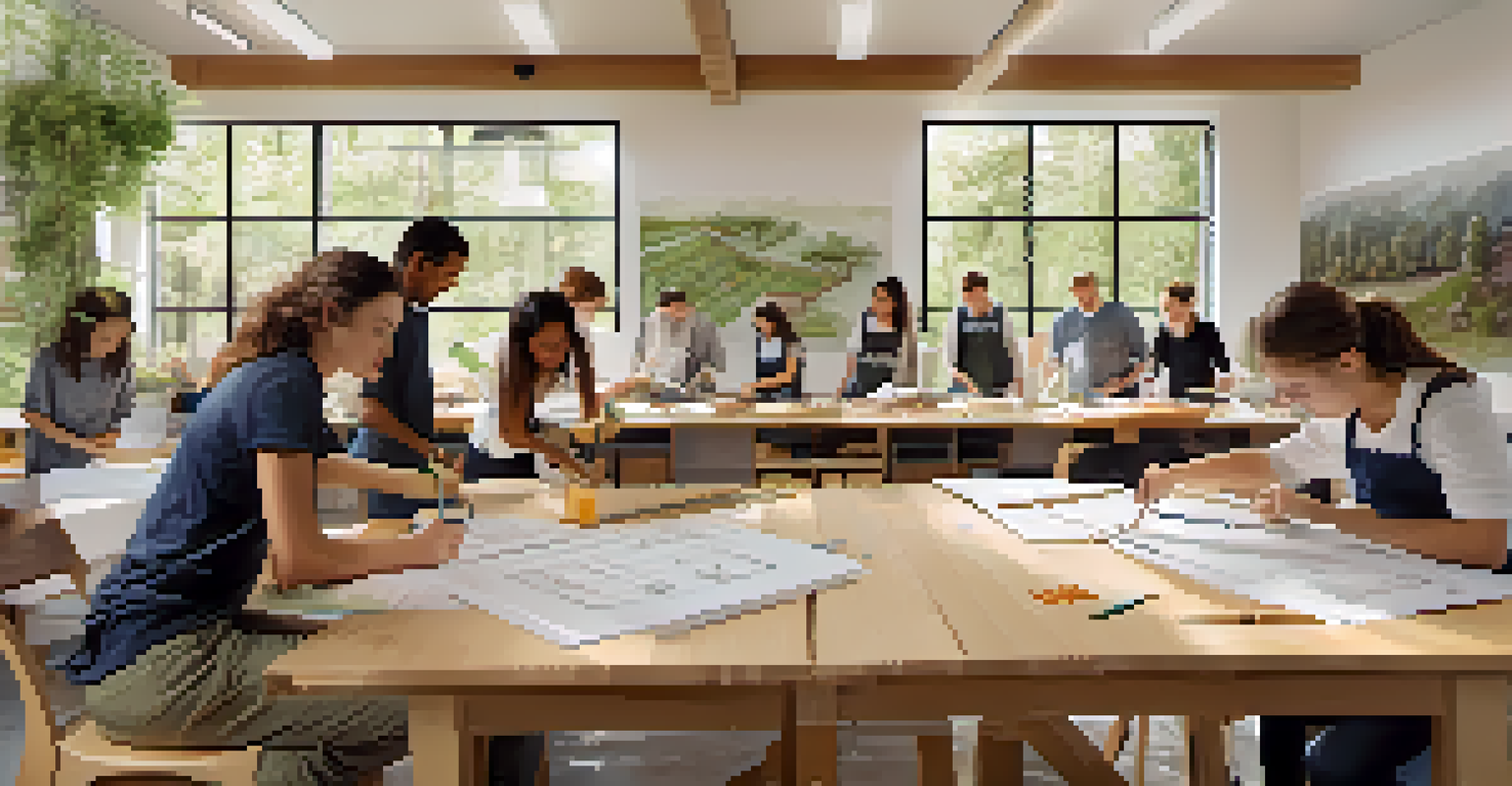The Importance of Education in Sustainable Home Design

Understanding Sustainable Home Design Basics
Sustainable home design focuses on creating spaces that are environmentally friendly and resource-efficient. This approach considers factors like energy consumption, material sourcing, and overall ecological impact. By understanding these fundamentals, homeowners can make informed choices that benefit not just their living environment but the planet as well.
Sustainability is no longer about doing less harm. It's about doing more good.
The principles of sustainable design include energy efficiency, water conservation, and waste reduction. For instance, using solar panels can significantly lower energy costs while reducing reliance on fossil fuels. Likewise, incorporating rainwater harvesting systems can help conserve water, making a home more sustainable.
Education plays a pivotal role in disseminating these ideas to future builders and designers. When designers are trained in sustainability, they can create homes that are not only beautiful but also beneficial for the environment, helping to foster a culture of sustainability in the community.
The Role of Education in Promoting Sustainable Practices
Education is key to promoting sustainable practices in home design, encouraging innovative thinking and creative solutions. By integrating sustainability into design curricula, aspiring architects and builders gain a deeper understanding of eco-friendly materials and energy-efficient technologies. This knowledge empowers them to make choices that minimize environmental impact.

Workshops, seminars, and hands-on training provide real-world experience that solidifies theoretical concepts. Students can engage with industry professionals, gaining insights into successful sustainable projects. This interaction not only enhances learning but also fosters a network of like-minded individuals passionate about sustainability.
Sustainable Design Benefits Everyone
Adopting sustainable home design practices not only reduces environmental impact but also enhances homeowners' quality of life.
Moreover, educational institutions can act as catalysts for change, leading local communities toward greener practices. By hosting community workshops and outreach programs, schools can disseminate valuable information about sustainable home design widely, inspiring homeowners to adopt eco-friendly solutions.
Incorporating Sustainability into Design Curricula
Integrating sustainability into design curricula is essential for preparing students for the future. Programs should include coursework on renewable energy sources, sustainable materials, and environmentally friendly construction methods. Such a curriculum equips students with the skills necessary to address modern challenges in home design.
The greatest threat to our planet is the belief that someone else will save it.
Real-world projects can be an effective teaching tool in these programs. By working on actual sustainable design projects, students can apply theoretical knowledge while gaining practical experience. This hands-on approach fosters problem-solving skills and encourages innovative thinking.
Furthermore, collaboration with sustainability-focused organizations can enhance educational programs. Partnerships can provide access to resources, expertise, and funding for projects, ensuring that students receive a well-rounded education in sustainable practices.
The Impact of Awareness on Consumer Choices
Consumer awareness significantly influences the demand for sustainable homes. When homeowners are educated about the benefits of sustainability, such as reduced utility costs and healthier living spaces, they are more likely to make eco-friendly choices. This shift in consumer behavior encourages builders and designers to prioritize sustainable practices.
Increased awareness can also lead to a greater appreciation for eco-friendly materials and technologies. For example, knowing how bamboo flooring is both stylish and sustainable may encourage homeowners to opt for such materials instead of traditional options. This conscious decision-making is crucial for driving change in the home design industry.
Education Drives Sustainable Practices
Integrating sustainability into design curricula equips future builders and architects with the knowledge to create eco-friendly homes.
Ultimately, education empowers consumers to ask the right questions and seek out sustainable solutions. By understanding the long-term benefits of sustainable home design, homeowners can make choices that align with their values and contribute to a healthier planet.
The Role of Professional Development in Sustainability
Ongoing professional development is vital for those in the home design industry. As sustainable technologies and practices evolve, professionals must stay informed to remain competitive and effective. Workshops, certifications, and continuous education programs can help them keep pace with the latest trends in sustainable design.
By investing in professional development, designers enhance their skills and broaden their knowledge base. This preparation enables them to offer innovative solutions that meet client needs while adhering to sustainable principles. It's a win-win situation for both the professionals and the environment.
Moreover, industry organizations can play an essential role by providing resources and networking opportunities. These connections facilitate knowledge sharing and collaboration, ensuring that the industry moves toward a more sustainable future as a collective effort.
Case Studies: Successful Sustainable Home Designs
Examining successful case studies in sustainable home design can provide valuable insights and inspiration. For instance, homes that utilize passive solar design principles showcase how natural light and heat can be harnessed to reduce energy consumption. These examples highlight the practical application of sustainable education in real-world scenarios.
Another noteworthy example is the use of recycled materials in construction. Projects that incorporate reclaimed wood or repurposed materials not only reduce waste but also add character to homes. These case studies demonstrate how educated designers can creatively use resources to achieve sustainability.
Consumer Awareness Fuels Change
Informed consumers are more likely to choose sustainable options, prompting the home design industry to prioritize eco-friendly practices.
By sharing these success stories, the industry can inspire others to adopt similar practices. Case studies serve as powerful reminders that sustainable home design is not only achievable but also beneficial for both homeowners and the environment.
The Future of Education in Sustainable Home Design
Looking ahead, the future of education in sustainable home design appears promising. As awareness of climate change and environmental issues increases, educational programs are likely to evolve to meet the demands of a sustainable future. This evolution will involve integrating new technologies and practices into curricula.
Emerging trends, such as smart home technology, will also play a significant role in shaping education. Teaching students how to design homes that incorporate smart energy management systems can lead to more efficient and sustainable living spaces. This forward-thinking approach prepares students to tackle upcoming challenges in the industry.

Ultimately, the commitment to sustainability in education will foster a new generation of designers who prioritize eco-friendly practices. As these future leaders emerge, the home design industry will likely become more sustainable, positively impacting communities and the planet.